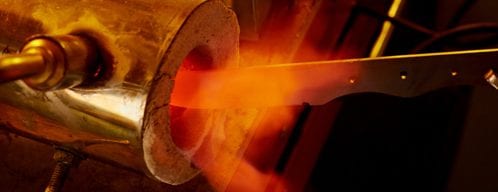General
Knife Making and the Properties of Steel
Welcome to our first blog, and being our first, we thought we would start from the very beginning…how knives are made and the properties of different steel used in that manufacturing process.
Making & Shaping
In choosing a knife you should pay particular attention to the type of steel used in the blade. Steel is really the essence of the blade and primarily responsible for how the knife performs. Steel is essentially an alloy (i.e. a mix) of carbon and iron that is often enriched with other elements (such as Manganese, Sulfur, Silicon, and Phosphorus) to improve certain characteristics depending on the desired application.
It is these additions that give different types of steel their special properties. Alloy steels that have additions to make them corrosion-resistant are labeled stainless steels, and these are the steels most frequently used in making knife blades. If nothing else is present, the steel is referred to as plain carbon steel.
The making of stainless steel begins by melting steel in a furnace. Alloying elements are added to the melt, and the molten steel is poured into molds called ingots.
Once the ingots have solidified, they are processed in a mill to make usable shapes and sizes (plates, coils, etc.). Buck Knives, for eg., uses plates and coils, depending on the type of steel and its thickness. Plates are turned into knife components by laser cutting and coils are shaped into components using a fine blanking press.
Steel and its Properties
Some of the important properties of blade steel are –
Hardness: Hardness is the ability to resist deforming when subject to stress and applied forces. Hardness in knife steels is often referred to as strength and is generally measured using the Rockwell C scale (aka “HRC”).
Toughness: Toughness is the ability to resist damage like cracks or chips when being used in heavy duty applications. This also defines the steel’s ability to flex without breaking. Chipping is a knife’s worst enemy and never easy to fix. Note that the stronger or harder the steel the less tough it will likely be.
Wear Resistance: Wear resistance is the steel’s ability to withstand damage from both abrasive and adhesive wear. Abrasive wear comes from softer surfaces coming in contact with rougher ones. Adhesive wear occurs when debris is dislodged from one surface and attaches to the other. Wear resistance generally correlates with the steel’s hardness but is also heavily influenced by the specific chemistry of the alloy. In steels of equal hardness, the steel with larger carbides (think microscopic, hard, wear resistant particles) will typically resist wear better.
Corrosion Resistance: The ability of the steel to resist deterioration as a result of reaction with its environment such as humidity, moisture and salt. Note that a high resistance to corrosion does involve a sacrifice in the overall edge performance.
Edge Retention: Edge Retention represents how long the blade will retain its sharpness when subject to periods of use. It’s what everyone talks about these days but unfortunately the measurement of edge retention lacks any defined set of standards and so much of the data is subjective. For me, edge retention is a combination of wear resistance and an edge that resists deformation combined with the time/use needed before resharpening.
Since no single material is superior in all property categories, knife manufacturers select materials that offer the optimum properties for the purpose intended.
We hope this blog helps with some of the basics of the manufacturing process, and probably more importantly, the properties of various steels and their intended uses.
Keep an eye out for our next BLOG, discussing the various available steels, their properties, which manufacturers use what materials, and what is great quality knife steel and what is at the lower end.
Cheers
Nebo Knives
Thanks to information on the Cold Steel and Buck Knives websites for use of this information.
